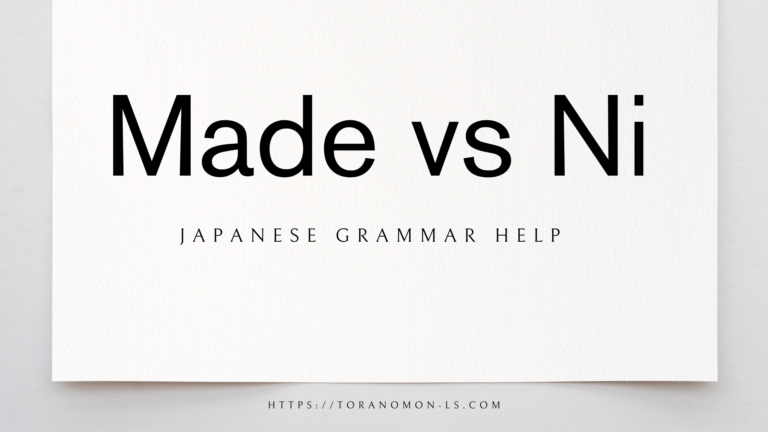Learn the difference between “made” and “ni”, as well as “made ni” in Japanese.
In Japanese, particles are used to connect parts of the sentence together. Using the wrong particle can completely change the meaning of the sentence, so it’s important to get it right.
Sometimes our students get confused over whether to use “made” or “ni” in their sentences. When do you use “made” and when do you use “ni” in Japanese? This blog will explain the differences between the two particles, and when to use each.
Made = until
The most simple way to explain is to say that “made” means until.
11 ji made nemashita = I slept until 11.
“Made” can be used when you are talking about a length of time or distance from the start to the end. The use of this particle expresses that there is a span of distance or time.
An example is to say “I walk 10 minutes to get to work”. You would say: shigoto made 10 pun aruku.
Since you are talking about the journey to get to work, which is getting from point A to B, you use “made”.
Ni = by, at
On the other hand, “ni” is used to express one singular moment, or a short period of time.
Let’s demonstrate this with an example.
If you want to say “I get to work at 9:10”, you would say: 9 ji 10 pun ni shigoto ni tsuki.
You are talking about the time at which you arrive, one single point in time, so you use “ni”. You also use “ni” to specify one single location, work.
Remember which is which by using these rules:
- When indicating a specific point in time over a span of time, “まで” is employed. For example:
- しゅくだいを30にちまでだします – I have until the 30th to submit my homework
- When expressing a physical limit or destination, “まで” is used. This indicates the destination/end point of the action. For instance here, made is used to indicate that school is the destination:
- 学校まで歩く (gakkou made aruku) – walk to school.
- “まで” can also imply an inclusive range. For example:
- 1から5まで (ichi kara go made) – from 1 to 5.
- “に” is commonly used to express a specific point in time, and just one time. For instance:
- 3時に (sanji ni) – at 3 o’clock.
- When indicating direction or a specific location, “に” is utilized. The point of using ni is to express the location where an action takes place. For example:
- 東京に行く (Tokyo ni iku) – go to Tokyo.
But what about “made ni”?
“Made ni” is different altogether! It’s usually used for actions that happen over a quick period, like popping out for some milk. So if you are doing something long-term, like a huge project, you wouldn’t use “made ni”.
The meaning is basically “by, before”.
For example:
10ふんまでにここにきてください -> ju pun made ni koko ni kite kudasai = Please come here within 10 minutes
or:
ともだちがくるまでに、いえをそうじします -> Tomodachi ga kuru made ni, ie o souji shimasu = I will clean the house before my friend comes over
Here are some sample questions to practice! Fill in the blanks with “made”, “made ni” or “ni”.
1. Jūnigatsu _________, Tōkyō ni sunde iru tsumori desu.
2. Eiga wa nan ji _________ hajimarimasu ka?
3. Raishuu, toshokan e iku _______, atarashii hon o yomu yotei desu ka?
4. Kono hon o yomiowaru _______, tsugi no hon o kaimasu.
5. Nichiyōbi _________, nani o suru yotei desu ka?
Answers:
Jūnigatsu made, Tōkyō ni sunde iru tsumori desu. = I’ll be living in Tokyo until December
Eiga wa nan ji ni hajimarimasu ka? = What time does the movie start?
Raishuu, toshokan e iku made ni, atarashii hon o yomu yotei desu ka? = Are you planning to read a new book before going to the library next week?
Kono hon o yomiowaru made ni, tsugi no hon o kaimasu. = I will buy the next book before finishing reading this one.
Nichiyōbi ni, nani o suru yotei desu ka? = What are your plans for Sunday?
If you are looking for Japanese lessons in Tokyo, Toranomon Language School has flexible lessons for all levels. Check out our classes and take a free trial and level assessment today!

